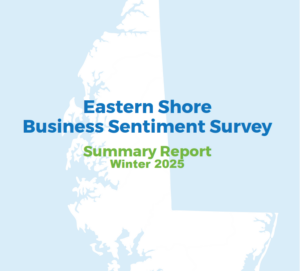
Salisbury, MD — Eastern Shore business owners and managers are less optimistic about the economic future than they were six months ago.
This trend is among the findings of the latest Eastern Shore Business Sentiment Survey conducted through a partnership with Salisbury University’s Business Economic and Community Outreach Network (BEACON), SU’s Eastern Shore Regional GIS Cooperative (ESRGC), and many of the region’s economic and workforce development professionals.
The January 2025 results represent the eighth report released by BEACON. The first survey in the series was conducted in June 2021, with subsequent six-month follow-ups.
The survey included more than 50 questions, asking business leaders to weigh in on a range of topics, from general business concerns to conditions in their own industries. Respondents evaluated business conditions locally, regionally, in the state and nationwide for the coming year. They also shared views related to their specific industries and on issues from labor supply to regulations.
Results include:
- The 12-month outlook for business conditions in participants’ respective counties is significantly worse than in July 2024. When asked to predict the business conditions in their counties and the Eastern Shore, 40% responded that they believe economic conditions will improve, compared to 66% in July 2024. On a state and national level, 38% of participants believe economic conditions will improve, compared to 57% six months earlier. When comparing opinions from a year ago the responses showed an improved outlook locally. When asked to predict the business conditions in their counties and on the Eastern Shore, 38% responded that they believe economic conditions will improve, compared to 27% in December of 2023.
- Reflecting on their individual industry sectors, business leaders’ expectations have declined since July but are slightly better than December 2023, with 3% more saying conditions are improving. Opinions are mixed, with 32% expecting conditions to improve in the next three months, while 31% expect conditions to remain the same and 37% expect conditions to deteriorate over the same period.
- Regarding unemployment, 50% predict it will be unchanged locally, with the remaining split between better or worse. When predicting unemployment at the state and national level, the responses were almost tied, with 32% expecting better and 34% each expecting it to be the same or worse.
- Inflation, labor force and financing remain the first-, second- and third-highest-ranked barriers for businesses expanding, the same as July 2024. Respondents ranked inflation slightly higher than in July. In ranking barriers to starting a business, the factors were the same but in opposite order with financing highest ranked followed by labor and inflation.
- When asked which cost increase in the previous six months had the greatest impact on the respondents’ businesses, they reported insurance had the highest impact, followed by payroll and benefits then utilities.
- Respondents are increasingly optimistic in their expectations of the standard of living in the next five years on the Eastern Shore, with 39% believing it will rise and only 13% believing it will fall.
- Participants had a less positive view on the current state of America’s economy than in July but more positive than in December 2023. Some 55% believe the economy is “Growing Rapidly/Growing Slowly,” compared to 64% in July and 42% in December 2023, and only 19% believe it is “In a Recession/Depression.”
- A majority of responses came from company leadership, with business owners, presidents, CEOs and managing partners making up 62% of the participants. A total of 75% were from firms with fewer than 50 employees. Responses came from a wide variety of industries reflecting the economy of the region, with many respondents active in more than one industry.
Counties on the Eastern Shore will continue to conduct the survey every six months, with the data used to identify challenges facing the region, to assist in long-term planning and to guide the development of public policy.
The Eastern Shore Regional GIS Cooperative (ESRGC) summarized the findings in infographics that can be found on the Eastern Shore Economic Recovery Project website, but economic developers also have access to an internal dashboard that enables them to mine the data for insight on specific issues.
Designed to gauge the opinions of the region’s business leaders, this survey is one of the tools that has grown out of the Eastern Shore Economic Recovery Project, a venture made possible by grants totaling $507,000 from the U.S. Economic Development Agency (EDA). The Mid-Shore Regional Council and the Tri-County Council of the Lower Eastern Shore are recognized as Economic Development Districts by the EDA.
The data tools used in the project have been recognized with regional and national accolades including the Maryland Economic Development Association’s 2022 Economic Development Program Award, the 2022 International Economic Development Council Silver Award and the 2022 National Association of Development Organizations (NADO) Aliceann Wohlbruck Impact Award.
In addition to the regional councils, partners in the project include ESRGC, BEACON, the Lower Shore Workforce Alliance, the Upper Shore Workforce Investment Board, and the Caroline, Cecil, Dorchester, Kent, Queen Anne’s, Talbot, Somerset, Wicomico and Worcester county economic development offices.
To access Eastern Shore Economic Recovery Project data, visit https://recovery.delmarvaindex.org. The complete Delmarva Index can be found at https://delmarvaindex.org.
For more information visit the BEACON webpage at www.salisbury.edu/beacon and the ESRGC website at www.esrgc.org.
Learn more about SU and opportunities to Make Tomorrow Yours at www.salisbury.edu.



